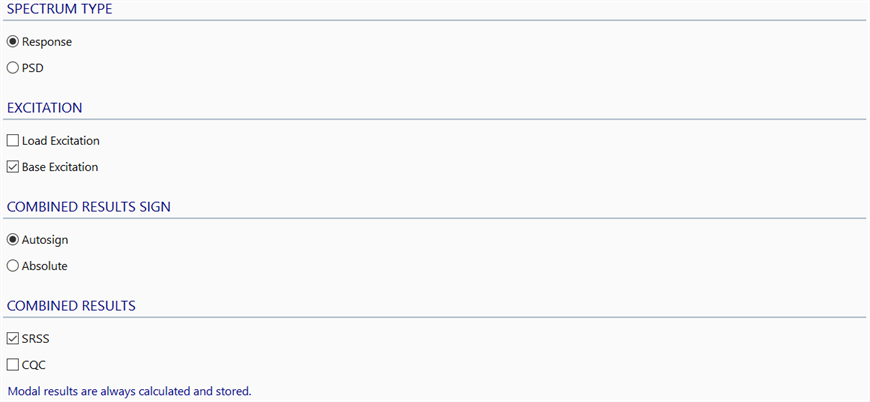SOLVERS Home: Spectral Response

Description
Solver parameters relevant to the Spectral Response solver.
SPECTRUM TYPE
Response
Sets the analysis type to Spectral Response.
Factor vs Frequency/Period tables with Factor Unit set to None or Response may be associated with the excitation.
PSD
Sets the analysis type to Power Spectral Density.
Factor vs Frequency/Period tables with Factor Unit set to None or PSD may be associated with the excitation.
EXCITATION
Load Excitation
If set, includes cases defined under the SOLVERS Load: Spectral Load Excitation sub-tab for analysis.
Base Excitation
If set, includes cases defined under SOLVERS Load: Spectral Base Excitation sub-tab for analysis.
COMBINED RESULTS SIGN
The spectral response solver calculates the results for each included mode (the modal result). Each modal result is an equilibrated and signed quantity that cycles between positive and negative values contributing to the total structural response based on the excitation. The modal results are then combined to calculate the total response of the structure. Due to the way the modal results are combined, using either the SRSS or CQC methods, the sign of combined results is lost. However, for the purpose of graphical visualisation of results, two options are given for the sign.
Autosign
The sign of each result quantity in the combined response is set as the sign of the mode with the largest modal contribution to that result.
Absolute
All results are given positive signs.
COMBINED RESULTS
Results for individual modes are always included in the results file. Combined results may also be calculated using the following methods.
SRSS
If set, an SRSS result case becomes available for each excitation case.
The SRSS result case is an estimate of the maximum response of the structure based on the square root of the sum of the squares method. SRSS results are not equilibrated results.
CQC
If set, a CQC result case becomes available for each excitation case.
The CQC result case is an estimate of the maximum response of the structure based on the complete quadratic combination method. CQC results are not equilibrated results.
Damping must be specified for the CQC method. Without damping, the CQC method reverts to SRSS.
See Also